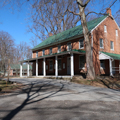Sandy Spring, the county’s oldest community, was founded c. 1728 by members of the Society of Friends and still maintains a vibrant Quaker presence. Early settlers James Brooke and John Thomas received land from father-in-law Richard Snowden, whose father was a Quaker dissenter and the recipient of a grant from Lord Baltimore. Their agrarian-based community encompassed a network of small plantations, tenanted farms, and mills situated near the headwaters of the Anacostia and Patuxent rivers. They engaged in experimental farming and established agricultural societies, making Sandy Spring one of the richest growing regions in the county. Life revolved around the meetinghouse (1817; 17715 Meeting House Lane), a Federal-period Flemish-bond brick building reflecting Friends’ Plain-style building traditions. Built by the Thomas family of master builders, it follows the prototypical form for American Friends meetinghouses with dual entrances for men and women. The property includes a burying ground dating to 1754 and the adjacent frame Community House or Lyceum erected in 1858–1859 to serve as a lecture hall and meeting place. Past the log-constructed Quaker farmstead Harewood (1794) is the freshwater spring that gave the community its name, and the woods beyond that were part of the Friends’ Underground Railroad network, now an interpretive trail.
Baltimore architects Ghequiere and May designed Colonial Revival brick buildings for Sandy Spring Bank and the Mutual Fire Insurance Company—institutions that reflect Friends progressive economic and social agenda—and the Cedars (1901; 1601 Olney-Sand Spring Road) for insurance company secretary-treasurer Allen Farquhar. More recently, architects Miche Booz and Thomas Bucci designed the Sandy Spring Museum (1996–2007; 17901 Bentley Road) as a multipart building delineated by function to resemble local buildings such as the meetinghouse.
A free Black settlement dating from the late eighteenth century, among the oldest in the state, is located along parts of Olney-Sandy Spring, Norwood, Brooke, and Chandlee Mill roads. Freed slaves were encouraged by Friends willingness to offer land and support for their own church and school, creating the largest of fourteen such enclaves that once existed in and around Sandy Spring. While most early houses have been replaced, the extant Hopkins House (c. 1900; 18470 Brooke) reflects those built by Black subsistence farmers. It now sits near the Slave Museum (1988; 18524 Brooke). The heart of the community is Sharp Street Methodist Church (1924; 1310 Olney-Sandy Spring), named for the “mother church” in Baltimore. A log church was first built c. 1822 with land and legally mandated oversight provided by Friends as the first independent Black organization in the county. The current church is the third on site. The adjacent two-story frame, gable-front Odd Fellows Hall (c. 1920) provided support services while serving as a social hall. This lodge was part of an Odd Fellows order established for African Americans founded in Baltimore in 1843.






























